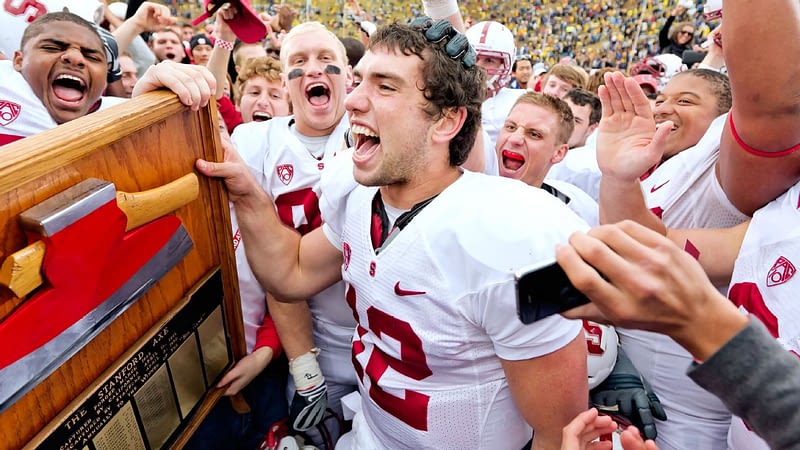Andrew Luck Returns to Stanford as Football Program’s General Manager
In a move that could shake up the landscape of college football, former Stanford star quarterback Andrew Luck is heading back to the Cardinal—but this time, he’s trading his helmet for a front-office role. Luck, 35, has been named the football program’s general manager, a newly created position that places him at the helm of both the football and business operations of the team. He confirmed the news in an exclusive phone interview with ESPN.
This isn’t your typical college football GM role. Luck’s responsibilities will span everything from managing the coaching staff and recruiting to overseeing sponsorships, fundraising, and even the in-stadium experience. Essentially, he’ll be the glue holding the entire program together, a role that could signal a shift in how college football programs are structured moving forward.
“I’m excited,” Luck told ESPN. “I think Stanford is taking an assertive and innovative step. We’re undoubtedly the best athletic department in college sports. We have to re-prove it in football, and we’re excited to be part of that challenge.”
Stanford’s Struggles and the Road Ahead
Stanford football has seen better days. The program has endured five losing seasons in the last six years, including back-to-back 3-9 campaigns. Luck’s mission is clear: help second-year head coach Troy Taylor rebuild the program and bring Stanford back into the national spotlight. Taylor, for his part, is thrilled about the partnership, calling it a unique opportunity to work alongside one of Stanford’s most celebrated alumni.
The idea for Luck’s new role came about “organically” during a conversation with Stanford president Jonathan Levin about a month ago. Levin reportedly asked Luck, “Why don’t you run football, Andrew?” For Luck, the answer was obvious. “I sort of have to. This makes too much sense,” he said with his trademark laugh. “I would not do this at any other place, not just me, but my wife, too. It’s a special place for me and a lot of people.”
A Homecoming for Luck
Luck’s ties to Stanford run deep. He’s not just a former player; he’s a proud graduate who returned in 2022 to earn a master’s degree in education, adding to his undergraduate degree in architectural design. He met his wife, Nicole Pechanec, a former Stanford gymnast, during his time at the university. Now, the couple and their two young daughters are thrilled to be back on campus.
“I’m a product of this place,” Luck said. “Besides my folks and the friends and extended family I grew up with, Stanford, this is home for my wife and I. I’m profoundly influenced by Jim Harbaugh, David Shaw, Pep Hamilton, and all the coaches and professors that I’ve ever had.”
Luck’s impact on Stanford football during his playing days was monumental. He helped end a seven-year streak of losing seasons when he became the starting quarterback in 2009. He famously chose to stay for his redshirt junior year in 2011, even though he was projected to be the top pick in the 2011 NFL Draft. During his tenure, Stanford embraced its “Nerd Nation” identity, with Luck deflecting praise and shining the spotlight on his teammates.
Can Stanford Return to Glory?
Luck believes the program can return to its former glory, but it won’t be easy. He pointed out that if a 12-team playoff had existed earlier this century, Stanford likely would have been in contention for a spot in six of seven years from 2010 to 2016. During that stretch, the Cardinal finished in the Top 12 of the Associated Press poll six times.
“Stanford is at its best when there’s alignment from the top of the university about football,” Luck said. He credited Levin and athletic director Bernard Muir for their commitment to innovation and creativity in helping the program compete in the modern era of college football.
Luck acknowledged that Stanford has been “slow to the draw” when it comes to adapting to new realities like NIL (Name, Image, and Likeness deals), the transfer portal, and leveraging unlimited transfers. However, he remains confident in the “unique value proposition” of a Stanford degree as a key selling point for recruits.
A Steep Learning Curve
While Luck is no stranger to football, he admits he’s stepping into uncharted territory. His experience comes from his time at Stanford, seven NFL seasons, and two years as a volunteer assistant coach at nearby Palo Alto High School. “I do not [have direct front-office experience], and I’m well aware of that,” he said. “I think I’m entering this with eyes wide open and aware of my strengths and my limitations. I know there’s a lot that I do not know. Part of that makes it exciting.”
Luck is eager to learn from Taylor and Muir, both of whom bring a wealth of experience to the table. “I’ve got a lot to learn from Troy. He’s been a winner everywhere he’s been,” Luck said.
A New Era for College Football?
If Luck and Taylor can turn Stanford into a winner again, it could inspire other programs to adopt a similar structure. As college athletics move toward a revenue-sharing model, the traditional setup—where head coaches hold all the power—may no longer make sense. This new model could allow coaches to focus more on coaching while leaving administrative duties to someone like Luck.
For Luck, this role is about more than just football. It’s a chance to give back to a place that shaped him. “I’m very thankful for what football has given me,” he said. “In many, many ways on many, many levels. Stanford is one of those deeper levels. There’s something about it, especially the people there. This is going to be a daunting challenge. It’s a steep climb. But I’m fired up. It’s going to take a whole team of people.”
Originally Written by: Pete Thamel





















